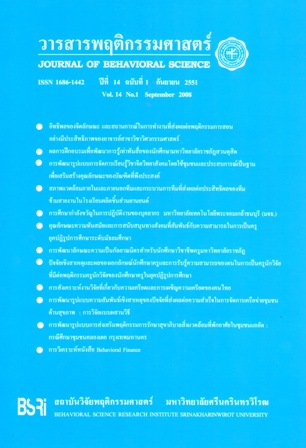ผลการฝึกอบรมเพื่อพัฒนาการรู้เท่าทันสื่อของนักศึกษา มหาวิทยาลัยราชภัฏสวนดุสิต (Effects of Training on Media Literacy Development of Suan Dusit Rajabhat University Students)
Abstract
The objectives of this research were to study the effects of training programs on media literacy development among the sample groups. The samples consisted of freshmen undergraduate students at Suan Dusit Rajabhat University. Those students were selected via stratified random sampling according to media self efficacy level and assigned equally into three groups :1) the experimental group A 2) the experimental group B and 3) the control group. Each group consisted of 20 students. The instruments used in this study were as following : (1) the media literacy test , (2) the media self efficacy test and (3) the module of media literacy development. Each sample was repeated measured 4 stages as following : stage1 : before the experiment , stage 2 : at the end of the media literacy development training for 10 sessions , stage 3 : at the end of project work practices ,and stage 4: one month after the project work practices. Media literacy scores of samples were analyzed with three way MANOVA with repeated measures The experimental data analyses revealed that there was no significantly statistical difference in the interaction of type of programs , level of media self efficacy and times of measurement . However, interaction between type of programs and times of measurement was found. Students who participated in the media literacy development training programs were higher media literacy score than those who did not participated the programs. According to the research finding , it suggested that the best program to develop media literacy was the combination of both the media literacy development training programs and project work practices.
บทคัดย่อ
การวิจัยนี้มีจุดมุ่งหมายเพื่อศึกษาผลของการฝึกอบรมเพื่อพัฒนาการรู้เท่าทันสื่อของนักศึกษา กลุ่มตัวอย่างได้แก่ นักศึกษามหาวิทยาลัยราชภัฏสวนดุสิต ระดับปริญญาตรี ชั้นปี 1 ที่อาสาสมัครเข้าร่วมโครงการฝึกอบรม หลังจากนั้นจึงนำมาสุ่มแบบแยกประเภท ( Stratified random sampling) ตามลักษณะของระดับการรับรู้ความสามารถของตนในการใช้ สื่อ และต่อมาทำการสุ่มนักศึกษาเข้ากลุ่มทดลอง 2 กลุ่มและกลุ่มควบคุม 1 กลุ่ม แต่ละกลุ่มมีจำนวน 20 คน เครื่องมือที่ใช้ในการศึกษาครั้งนี้ ได้แก่ (1) แบบวัดการรู้เท่าทันสื่อ (2) แบบวัดการรับรู้ความสามารถของตนในการใช้สื่อ และ(3) ชุดฝึกอบรมเพื่อการพัฒนาการรู้เท่าทันสื่อที่ ทำการวัดการรู้เท่าทันสื่อ 4 ครั้ง คือ ก่อนการทดลอง, ภายหลังการฝึกอบรมระยะที่ 1 (10 กิจกรรม), ภายหลังการฝึกอบรมระยะที่ 2 (การฝึกทำโครงการ) และติดตามผลหลังการฝึกทำโครงการแล้ว 1 เดือน หลังจากนั้นนำข้อมูลมาวิเคราะห์โดยใช้การวิเคราะห์ความแปรปรวนหลายตัวแปร 3 ทางแบบวัดซ้ำ (Three way MANOVA with Repeated Measure) ผลการวิจัย พบว่า ไม่มีปฏิสัมพันธ์ระหว่างรูปแบบการฝึกอบรม ระดับการรับรู้ความสามารถของตนในการใช้สื่อ และครั้งของการวัดต่อการรู้เท่าทันสื่อของนักศึกษาในด้านการคิดวิจารณญาณ ด้านการตระหนักถึงผลกระทบของสื่อและด้านการเลือกรับและใช้สื่ออย่างมีประสิทธิภาพ แต่พบว่ามีปฏิสัมพันธ์ระหว่างครั้งของการวัดกับรูปแบบการฝึกอบรมต่อการรู้เท่าทันสื่อของนักศึกษา นักศึกษาที่ได้รับการฝึกอบรมเพื่อพัฒนาการรู้เท่าทันสื่อมีคะแนนเฉลี่ยการรู้เท่าทันสื่อสูงกว่านักศึกษาที่ไม่ได้รับการฝึกและรูปแบบที่ดีที่สุดในการพัฒนาการรู้เท่าทันสื่อของนักศึกษา คือ การฝึกอบรมเพื่อพัฒนาการรู้เท่าทันสื่อทั้ง 3 ด้านคือ ด้านการคิด ความรู้สึก/จิตใจและพฤติกรรมร่วมกับการฝึกทำโครงการ
คำสำคัญ : การรู้เท่าทันสื่อ การรับรู้ความสามารถของตนในการใช้สื่อ การทดลอง
Downloads
Downloads
How to Cite
Issue
Section
License
Behavioral Science Research Institute, SWU
114 Sukhumvit 23, Bangkok 10110, Thailand.
Tel.02-649-5000 # 17600



